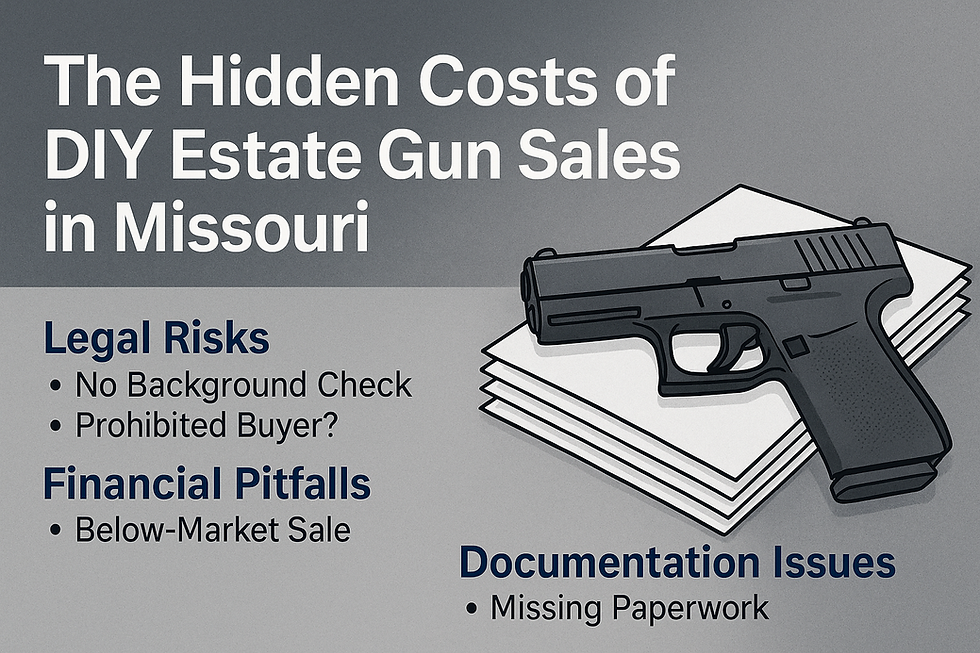What’s My Gun Really Worth?
- Drew McDermott

- Jul 17
- 4 min read
Updated: Aug 22
Understanding Price vs. Value in the Real World
Every week, we hear the same thing from private sellers:
“I paid $1,200 for this, and it’s still in perfect condition, I saw it listed on GunBroker for $2,000, why are you offering less?”
We get it. Firearms aren’t just objects, they’re investments, heirlooms, and sometimes even symbols of trust. But when it comes time to actually selling a gun, many sellers confuse what it cost with what it’s worth in today’s market.
This post breaks down the difference between Fair Market Value (FMV) and Marketable Cash Value (MCV), and explains why you may be offered less than you expect (and why that’s not a scam).
Fair Market Value vs. Marketable Cash Value: A Quick Primer
Before we talk about emotion, let’s talk about math.
At MDRF Enterprises, we calculate Fair Market Value by averaging:
Recent GunBroker.com listings with active bids
Paid for, At Auction, Realize Price sales data
Plus, model-specific market demand and condition
That gives us the price a gun is realistically selling for, not just what someone listed it at.
But most private sellers aren’t using those tools. They’re basing expectations on:
Their original purchase price (often full retail, new in box)
A few high-priced GunBroker listings (with no bids)
Rumors or outdated appraisals
Let’s break that down.
Common Pricing Myths We Hear
1. “I paid $X, so it’s worth $X.”
Once you buy a gun, especially new in box, it immediately becomes used. Like a car driven off the lot, it loses retail value the moment it leaves the case.
Even if it’s “barely shot,” it’s still:
Missing warranty protection
Potentially missing original box/papers
No longer legally NIB (New in Box)
Used condition = used value.
2. “It’s listed for $Y on GunBroker.”
There’s a huge difference between:
Asking price, and
Selling price
We see this all the time: a Colt Python listed at $3,000 but no bids, 9 re-listings in a row.
GunBroker is like eBay, it reflects what sellers hope to get, not always what they receive. That's why we only consider closed listings with bids in our FMV estimates.
3. “You’re lowballing me.”
No, we’re giving you the Marketable Cash Value: the realistic amount a seller walks away with after fees, delays, and friction.
Platforms like GunBroker or auction houses often charge 10–15% in fees. Factor in the time it takes to photograph, list, answer questions, and ship, and the buyer still wants a deal.
MDRF offers a streamlined alternative: We calculate FMV, subtract 30% to reflect real-world liquidity, and provide a fair, no-hassle cash offer. No auctions. No wait.
And here’s something most sellers don’t realize: as a licensed dealer, we can often purchase current-production firearms from our wholesalers at 30–40% less than the retail price they originally paid. That’s not a reflection of the gun’s quality, it’s just how margins and manufacturer pricing work in the industry.
Infographic: FMV vs. MCV – What’s the Real Difference?
Title: "Understanding Firearm Value: FMV vs. Marketable Cash Value"

This visual lays out:
How FMV is calculated using market data
How MCV reflects what sellers actually receive
Why MDRF applies a consistent, transparent 30% discount (not arbitrary lowballing)
Real examples with typical firearms
At MDRF Enterprises, every certified firearm appraisal includes both Fair Market Value and Marketable Cash Value, giving you a realistic view of what a firearm is worth today. If you’re handling probate or trust administration, see how we work directly with estate attorneys to provide court-ready documentation.
Real-World Example
Let’s say you have a Smith & Wesson 686, lightly used, with a few handling marks.
You paid $950 new at retail.
Current FMV (based on GunBroker + At Auction Service) is $775–$825.
MDRF would offer around $550–$575 in cash, based on MCV.
You skip the 3-week auction wait, the 15% fees, the no-show buyers, and the legal liability.
Learn more about our certified firearm appraisal process and how we determine value accurately on our Appraisals page.
Who This Helps
Heirs who need a quick, fair valuation during probate
Collectors looking to offload duplicates or thin their safes
Executors or liquidators who don’t want to mess with shipping and background checks
"If you’re handling the entire cleanout process, check out our Estate Firearm Checklist."
"Read more on executor responsibilities for firearms in Missouri."
We’re not here to haggle, we’re here to provide clarity and help you move forward confidently.
"And if you're not sure about your legal role, see our post on whether executors or liquidators need a license."
If you’re an estate attorney, fiduciary, or trust officer, explore our dedicated resources for professionals to assist your clients with confidence and compliance.
Bottom Line: Don’t Fall for Listing Price Illusions
Gun value isn’t about what you paid, or what someone wants on GunBroker, it’s about what someone will actually pay you today, minus all the red tape.
At MDRF Enterprises, we:
Give you both FMV and MCV
Base our numbers on real comps, not guesswork
Work on a flat, transparent margin
Help you comply with state and federal law
No pressure. No surprises. Just clear options from a licensed professional who values your time and your firearm.
Planning to transfer a firearm out of state or through an estate? Be sure to review our blog on shipping a gun if you’re not a licensed dealer to avoid common legal pitfalls.
Want to Know What Yours is Worth?
Visit our FAQ: Firearms and Unlicensed Persons
For a deeper understanding of how to manage inherited firearms, download our Estate Firearms Guide. It’s designed for heirs, attorneys, and anyone navigating legal firearm transfers.
By:
Drew
Gun Buyer | St. Louis, MO | MDRF Enterprises







Comments